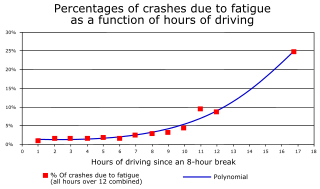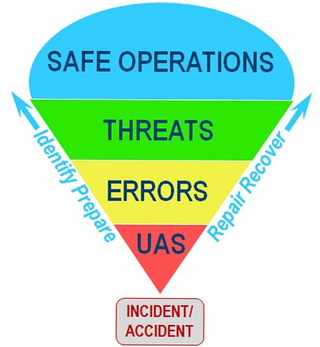In science and engineering, root cause analysis (RCA) is a method of problem solving used for identifying the root causes of faults or problems. It is widely used in IT operations, manufacturing, telecommunications, industrial process control, accident analysis, medicine, healthcare industry, etc. Root cause analysis is a form of inductive and deductive inference.
In aviation, a controlled flight into terrain is an accident in which an airworthy aircraft, fully under pilot control, is unintentionally flown into the ground, a mountain, a body of water or an obstacle. In a typical CFIT scenario, the crew is unaware of the impending collision until impact, or it is too late to avert. The term was coined by engineers at Boeing in the late 1970s.

Aviation safety is the study and practice of managing risks in aviation. This includes preventing aviation accidents and incidents through research, educating air travel personnel, passengers and the general public, as well as the design of aircraft and aviation infrastructure. The aviation industry is subject to significant regulation and oversight.
Task analysis is a fundamental tool of human factors engineering. It entails analyzing how a task is accomplished, including a detailed description of both manual and mental activities, task and element durations, task frequency, task allocation, task complexity, environmental conditions, necessary clothing and equipment, and any other unique factors involved in or required for one or more people to perform a given task.
In the field of human factors and ergonomics, human reliability is the probability that a human performs a task to a sufficient standard. Reliability of humans can be affected by many factors such as age, physical health, mental state, attitude, emotions, personal propensity for certain mistakes, and cognitive biases.

Pilot error generally refers to an accident in which an action or decision made by the pilot was the cause or a contributing factor that led to the accident, but also includes the pilot's failure to make a correct decision or take proper action. Errors are intentional actions that fail to achieve their intended outcomes. The Chicago Convention defines the term "accident" as "an occurrence associated with the operation of an aircraft [...] in which [...] a person is fatally or seriously injured [...] except when the injuries are [...] inflicted by other persons." Hence the definition of "pilot error" does not include deliberate crashing.

Accident analysis is a process carried out in order to determine the cause or causes of an accident so as to prevent further accidents of a similar kind. It is part of accident investigation or incident investigation. These analyses may be performed by a range of experts, including forensic scientists, forensic engineers or health and safety advisers. Accident investigators, particularly those in the aircraft industry, are colloquially known as "tin-kickers". Health and safety and patient safety professionals prefer using the term "incident" in place of the term "accident". Its retrospective nature means that accident analysis is primarily an exercise of directed explanation; conducted using the theories or methods the analyst has to hand, which directs the way in which the events, aspects, or features of accident phenomena are highlighted and explained. These analyses are also invaluable in determining ways to prevent future incidents from occurring. They provide good insight by determining root causes, into what failures occurred that lead to the incident.

The Human Factors Analysis and Classification System (HFACS) identifies the human causes of an accident and offers tools for analysis as a way to plan preventive training. It was developed by Dr. Scott Shappell of the Civil Aviation Medical Institute and Dr. Doug Wiegmann of the University of Illinois at Urbana-Campaign in response to a trend that showed some form of human error was a primary causal factor in 80% of all flight accidents in the Navy and Marine Corps.
A Technique for Human Event Analysis (ATHEANA) is a technique used in the field of human reliability assessment (HRA). The purpose of ATHEANA is to evaluate the probability of human error while performing a specific task. From such analyses, preventative measures can then be taken to reduce human errors within a system and therefore lead to improvements in the overall level of safety.

Fatigue is a major safety concern in many fields, but especially in transportation, because fatigue can result in disastrous accidents. Fatigue is considered an internal precondition for unsafe acts because it negatively affects the human operator's internal state. Research has generally focused on pilots, truck drivers, and shift workers.
The IATA Accident Classification Task Force (ACTF) analyses and classifies commercial aviation accidents for jet aircraft with a maximum takeoff weight of more than 20 tons and for turboprops of more than 5,7 tons (metric). The task force holds its annual meeting typically early in January to discuss, analyse and classify the accidents of the previous year. A special Accident Classification system based on a Threat and Error Management Framework is applied. The task force comes up with recommendations to enhance safety of air transportation. The outcomes, including statistical data, correlations and accident causations are published in the annual IATA Safety Report.
A safety taxonomy is a standardized set of terminologies used within the fields of safety and health care. The goal is to foster clear communication, as the terminology used within these fields can be immensely confusing, even to specialists.
Human factors are the physical or cognitive properties of individuals, or social behavior which is specific to humans, and influence functioning of technological systems as well as human-environment equilibria. The safety of underwater diving operations can be improved by reducing the frequency of human error and the consequences when it does occur. Human error can be defined as an individual's deviation from acceptable or desirable practice which culminates in undesirable or unexpected results.
Dive safety is primarily a function of four factors: the environment, equipment, individual diver performance and dive team performance. The water is a harsh and alien environment which can impose severe physical and psychological stress on a diver. The remaining factors must be controlled and coordinated so the diver can overcome the stresses imposed by the underwater environment and work safely. Diving equipment is crucial because it provides life support to the diver, but the majority of dive accidents are caused by individual diver panic and an associated degradation of the individual diver's performance. - M.A. Blumenberg, 1996
Maritime resource management (MRM) or bridge resource management (BRM) is a set of human factors and soft skills training aimed at the maritime industry. The MRM training programme was launched in 1993 – at that time under the name bridge resource management – and aims at preventing accidents at sea caused by human error.
The AcciMap approach is a systems-based technique for accident analysis, specifically for analysing the causes of accidents and incidents that occur in complex sociotechnical systems.

In aviation safety, threat and error management (TEM) is an overarching safety management approach that assumes that pilots will naturally make mistakes and encounter risky situations during flight operations. Rather than try to avoid these threats and errors, its primary focus is on teaching pilots to manage these issues so they do not impair safety. Its goal is to maintain safety margins by training pilots and flight crews to detect and respond to events that are likely to cause damage (threats) as well as mistakes that are most likely to be made (errors) during flight operations.
Aviation accident analysis is performed to determine the cause of errors once an accident has happened. In the modern aviation industry, it is also used to analyze a database of past accidents in order to prevent an accident from happening. Many models have been used not only for the accident investigation but also for educational purpose.

In aviation, the SHELL model is a conceptual model of human factors that helps to clarify the location and cause of human error within an aviation environment.
Investigation of diving accidents includes investigations into the causes of reportable incidents in professional diving and recreational diving accidents, usually when there is a fatality or litigation for gross negligence.

The European Helicopter Safety Team (EHEST) was a European aviation safety improvement initiative focusing on improving helicopter safety in Europe and worldwide. It was established in 2006 as part of the European Strategic Safety Initiative (ESSI) of the European Aviation Safety Agency (EASA). The goal of the European Helicopter Safety Team was to contribute to reducing the worldwide helicopter accident rate by 80% in the time-span 2006-2016, which was set as a goal by the International Helicopter Safety Team (IHST) in 2006. Focusing on European helicopter operators and manufacturers, the European Helicopter Safety Team conducted helicopter accident analyses, provided technology potential studies, and published safety management and training documents.







